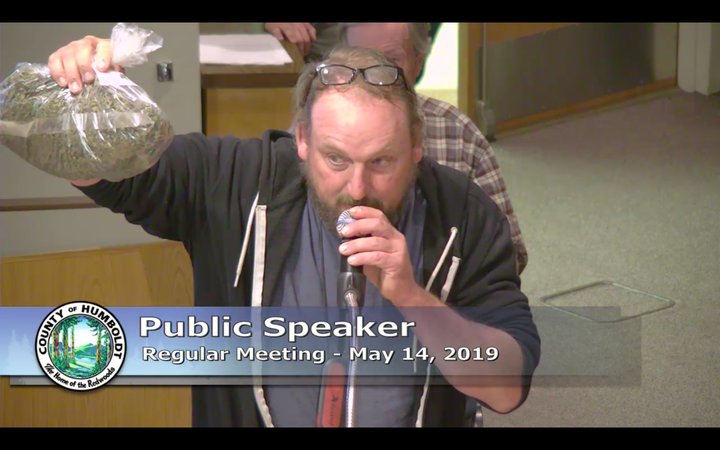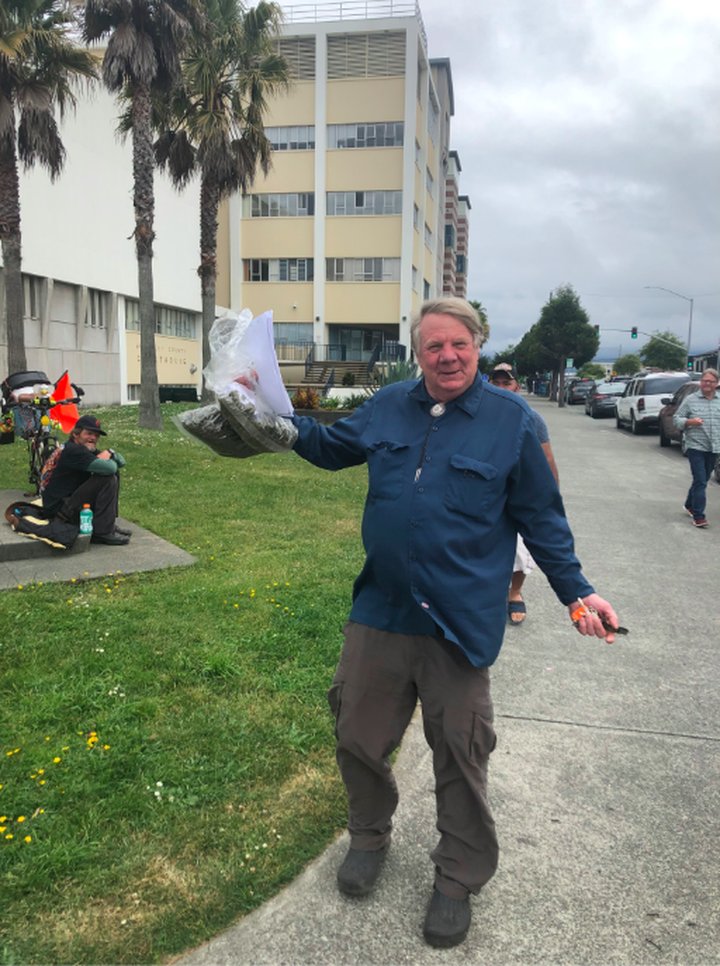
Mark Switzer, owner of Palo Verde Ranch, holds up a bag of Oregon-produced CBD hemp at the Humboldt County Board of Supervisors meeting. | Video screenshot.
After some convoluted and, at times, testy deliberation, a shorthanded Humboldt County Board of Supervisors today decided to take a cautious approach to regulating hemp cultivation in the county’s unincorporated areas.
With Fourth District Supervisor Virginia Bass absent, the balance of the board had two decisions to make: First was to identify an approach to regulating industrial hemp, which is cannabis — the same plant whose THC-laden buds will get you high. The distinction, per state and federal law, is that hemp can’t have more than 0.3 percent of the psychoactive compound THC or else it’s considered marijuana, which is still a Schedule 1 substance.
The second decision was whether or not to extend a moratorium on hemp cultivation that was brought forward last month by the county’s agricultural commissioner, Jeff Dolf, and approved by the board on April 2. The idea behind the moratorium was to give staff time to develop hemp regulations.
Ultimately the board decided to punt on that latter question, directing staff to bring back an urgency moratorium next week.
Fifth District Supervisor Steve Madrone had indicated that he opposed a moratorium, arguing that growers already face too many regulations. And with a four-fifths vote required to pass the moratorium extension, Board Chair Rex Bohn suggested postponing the decision until all five supervisors will be in attendance.
That vote passed 3-1, with Madrone dissenting. (More on his viewpoint below.)
In a separate motion, the board directed staff to prepare an ordinance regulating hemp production. That vote also broke 3-1, with Madrone dissenting. Staff plans to have the ordinance prepared and ready for board consideration by September.
The whole issue of hemp production was thrust into the regulatory limelight this past fall with passage of the 2018 federal farm bill, which legalized the commercial production of industrial hemp in the U.S.
In talking about hemp it’s important to distinguish between the kind grown for its seeds or fiber (the former is used in foods, the latter in rope and fabric) and the kind grown for its cannabidiol (CBD), a non-psychoactive compound commonly used to treat conditions such as anxiety, movement disorders and pain.
Industrial hemp — the kind grown for seeds or fiber — requires male plants and is grown like any other row crop you might see in mass production in the Central Valley. CBD hemp, on the other hand, looks exactly like the cannabis we know here in the Emerald Triangle, with female-only plants carefully cultivated to produce flower or “buds.”
The county staff report includes a handy chart illustrating the differences in the two types of hemp:
| INDUSTRIAL HEMP | PCR/CBD-RICH HEMP |
|---|---|
| Grown closely packed together | Grown in pots/plots or hydroponically |
| Just inches between plants | A few feet between plants |
| Grown with little tending | Grown with care |
| Grown using little or no nutrients | Grown using complex nutrients |
| Grown tall and spindly | Grows shorter and bushier |
| Never “topped,” one large seed cluster | Topped, abundant resinous buds |
| Harvested before maturity for fiber | Grown to maturity |
| Males are required for seed production | Males are detrimental and culled |
| Low in cannabinoids and terpenes | High in cannabinoids and terpenes |
| Not as strong-smelling | Smells like marijuana |
| Looks like reeds | Looks like marijuana |
| Harvested with tractors | Harvested by hand |
| Processed by machinery | Processed by hand |
| Strains with long genetic lineage | A recently developed strain of THC-free marijuana |
Some local farmers see financial opportunities in CBD-hemp and have urged the board to green-light its production, but many existing cannabis farmers say hemp production poses a major threat to the local industry due to the risk of pollen contamination.
“Wind widely distributes the pollen from male hemp plants, seeding feminized cannabis and CBD-hemp crops that are often located many miles away,” the Humboldt County Growers Alliance said in correspondence prepared for today’s meeting.
John Ford, the county’s director of planning and building, told the board this morning that staff was recommending an extension to the moratorium due to “the great amount of uncertainty as to what hemp might mean to Humboldt County.”
Ford went on to explain that the two extremes in terms of regulating hemp production would be, on the one hand, to treat it just like a row crop, allowing it to be planted and irrigated on agricultural parcels across the county, or, on the other hand, to lump it in with the county’s existing cannabis ordinance, making hemp subject to the same rules and regulations as commercial weed.
Second District Supervisor Estelle Fennell said she’s not at all clear about whether the feds intended to legalize CBD-hemp production when they included hemp in last year’s farm bill, but regardless, major corporations such as Coca Cola are “throwing millions and billions of dollars” into the CBD market.
“There’s so much more to learn,” Fennell said. “It’s amazing the federal government is taking this step.”
Humboldt County Sheriff Billy Honsal weighed in, urging the board to regulate hemp in the context of the existing Commercial Cannabis Land Use Ordinance.
“We’re going to create a huge issue for countywide enforcement if we allow unregulated hemp outside the county process,” Honsal said.
Third District Supervisor Mike Wilson took a metaphorical step back to give a philosophical perspective, saying he that sympathizes with people who are “frustrated with this convoluted conversation about regulating a plant,” but that regulations are necessary as our culture attempts to transition out of the “culture war” that has defined cannabis law over the past century.
Most who spoke during the public comment period touted the benefits and opportunities of CBD-hemp production. Arcata resident Vonnie Carol said CBD has liberated her from the chronic and sometimes crippling pain of fibromyalgia and other ailments but lately she’s been unable to find the low-THC strains she uses as medicine.
Mark Switzer, owner of Palo Verde Ranch, brought gallon-size zip-lock baggies to the lectern. One, he said, was full of CBD-hemp from Oregon, where hemp production and exportation is currently allowed. He held the bag aloft to display its inferior quality.
The other bag, he said, contained far superior CBD-hemp grown here in Humboldt. Switzer said he’s been placed at an unfair competitive disadvantage by having to price his own product, grown under the county’s restrictive cannabis rules, against cut-rate Oregon hemp, and he urged the board to make hemp production “an ag department issue.”
But Scott Davies, a board member of the Humboldt County Growers Alliance and owner of several cannabis companies, including Winterbourne Farms, said he’s already cultivating CBD under the county’s cannabis rules and regulations, devoting 30 percent of his farm’s production to those strains. Treating hemp as an agricultural product and allowing large-scale cultivation would jeopardize the entire local industry with the risk of cross-pollination, he said.
Davies also argued that allowing hemp cultivation outside of the established regulatory framework would place a heavy burden on those who are already in compliance with those rules.
Terra Carver, executive director of the Humboldt County Growers Association Alliance, said her organization opposes “pollinating” industrial hemp varieties due to the risk of contamination but supports inclusion of CBD-hemp under the county’s existing cannabis ordinance.
The Emerald Triangle of Humboldt, Mendocino and Trinity counties has an unparalleled genetic library for cannabis strains, Carver said, and allowing pollinating hemp would be akin to “clearcutting the Amazon of cannabis for a speculative quick buck.”
When the matter came back to the board, Fennell said it would be important for staff to include input from industry insiders as they develop a new ordinance. She made a motion to extend the moratorium and direct staff to work on that ordinance, incorporating CBD-hemp into the existing regulatory framework while not closing the door entirely on industrial or “pollinating” hemp. Wilson seconded the motion.
But if there were any illusions that the board members were all on the same page, they evaporated when Fifth District Supervisor Steve Madrone weighed in. He doesn’t support the county’s current cannabis ordinances, saying they’re so onerous that they’re causing the local industry to crash.
“The industry is struggling on many, many levels,” Madrone said.
He had hoped staff would come to today’s meeting with some new, less restrictive policies ready to implement so farmers who want to grow hemp this year don’t “lose the season.”
“I have a lot of concerns, and I don’t think the option of moving [hemp] into the highly regulated ordinance process is the solution,” Madrone said, adding that he would rather allow the moratorium to expire.
Wilson cautioned that the only alternative to the moratorium was to “just let ‘er rip [and] see what happens.” Current state law says that without local regulations, county agricultural commissioners “shall” approve applications to grow hemp.
Fennell said that while she appreciates Madrone’s sentiment, cannabis remains a Schedule 1 substance at the federal level, so it must be regulated.
But Madrone stuck to his guns. “I’m looking for something to be done immediately,” he said. “I just don’t see what’s being proposed as getting it done and doing it right.”
Ford took a turn trying to talk him down. With the caveat that he wasn’t trying to be argumentative, the planning and building director called Madrone’s desire for a ready-to-implement ordinance at today’s meeting “chronologically infeasible.”
“It’s not possible to do things immediately, in terms of developing and adopting an ordinance,” Ford said.
Madrone said a more free-market approach would be fine since hemp growers would still be registered with the county, and there are instruments capable of testing to ensure that the hemp being grown falls below the required 0.3 percent THC.
“For me, I don’t see this as some big, bad thing happening,” Madrone said. “We have the time to get things right, but I don’t want to lose this season. … I’d love to roll back overregulation. … I don’t support the moratorium. I’m sorry.”
Bohn, seeing the writing on the wall, then suggested that Fennell withdraw her motion until next week, when Bass will be back and the board will have a shot of getting the four-fifths vote required to pass the moratorium.
Fennell agreed and withdrew her motion.
That means the county’s moratorium on hemp cultivation will expire on Friday, but that doesn’t mean the floodgates for industrial hemp production will open immediately. It would take county staff at least a couple of weeks to process an application, Dolf said, so if the board manages to approve the urgency moratorium at next week’s meeting, it will delay the prospect until September at the earliest. That’s when staff expects to come back with a new ordinance to regulate hemp cultivation in Humboldt County.
# # #
Postscript: Carver, the growers alliance leader, snapped the following photo of Kent Sawatzky, the county’s most frequent public commenter, as he left today’s meeting having snagged the zip-lock bags of inferior Oregon hemp, apparently left behind by Switzer. (Sawatzky has recently started medicating with CBD.)

CLICK TO MANAGE